
Geographical hints: - Thrissur district was formed in July 1, 1949 ,The south east corner area of the district extends up to Tamilnadu Border. 54Km Seashore. Most of the areas in the district are low lands and midland. Machanadu, Paravattani,Palappilly, Kodasserry, Athirappilly are the important hills. Rivers: Kecherri, Karuvannur, Chalakudy Forest land: 103,610 hectare
Thrissur an abbreviation of Thiru-Siva-Peruru has always been referred to as the cultural capital of Kerala. Thiru denotes holiness and not three. The central and the most important feature is Vadakkunnathan Kshetram where the reigning deity is Lord Siva.
Centrally located in the State of Kerala this district is a rich reservoir in history, culture and archaeological remains. Thrissur Pooram, for long as one can remember the two dominant temple groups hallowed by many temples in Thiruvambadi and Paramekkavu clans look into a friendly combat for supremacy, is celebrated every year during April- May.
There are several important points of tourist attraction in Thrissur.
This is not just another place for worship. It has been the repository of culture and heritage unparalelled in Kerala history. Vadakku does not represent North and it is the corruption of the word 'Edvam' or 'Sacred Bull'.
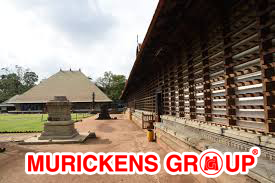 Kunnu is the Malayalam word for a hillock Edvakkunnathan thus became Vadakkunnathan. The deity is Lord Siva represented by 'Mahalingam' which now cannot be seen due to the mount formed by the traditional offerings or abhisheka with ghee. The exquisite murals on this shrine narrate the story of the epic Mahabharatha. The decorative wall paintings and carvings alone are worth a visit.
Kunnu is the Malayalam word for a hillock Edvakkunnathan thus became Vadakkunnathan. The deity is Lord Siva represented by 'Mahalingam' which now cannot be seen due to the mount formed by the traditional offerings or abhisheka with ghee. The exquisite murals on this shrine narrate the story of the epic Mahabharatha. The decorative wall paintings and carvings alone are worth a visit.
On the left of the entrance one can see the famous Kuthambalam a beautiful structure with an elegant sloping roof of metal plates. Ancient dramatic form of Chakkiar Koothu is staged here.Thrissur district in Kerala is known for its rich culture and heritage. Being the place that hosts Thrissur Pooram, the festival of festivals, Thrissur also has many other reasons to be proud of. Several unique attractions like Vadakkunnathan Temple, Punnathur Kotta (Palace of elephants) and Kalamandalam make the district one of the culturally strong places in Kerala. Vadakkunnathan Temple, or Vadakkumnathan Temple, in Thrissur is one of the most popular temples in Kerala. It is believed to be the first Shiva temple built by Lord Parasurama who is the sixth incarnation of Lord Vishnu. This temple is however one of the UNESCO recognised heritage sites. The temple is also known as Thenkailasam or Vrishabhachalam.
The temple is built in typical Kerala style architecture, located on a hillock in the heart of Thrissur city. Standing tall in the centre of 9 acres of land, the temple doesn't fail to grab attention of the passers-by. There are 4 gateways called gopurams to the temple facing East, West, North and South respectively. The temple is known for the rare murals portrayed here that include scenes from Mahabharatha, of which Vasukishayana and Nrithanatha are worshipped daily. Apart from these murals, the temple also houses a museum that showcases ancient paintings, woodcarving and other works of art of ancient times. The Koothambalam of the temple, or the temple theatre, is rich in its display of wooden carved vignettes. Koothambalam is used for staging ritualistic art forms of Central Kerala like Koothu, Koodiyattam and Nangyar Koothu. The three main shrines in this temple are of Sri Vadakkunnathan (Lord Shiva), Lord Shankaranarayana and Lord Rama. Goddess Parvati is also worshipped here. One for the strange aspects of the temple is that the ghee offered here for centuries doesn't melt, even in scorching summers. It is also believed that if the ghee covering the linga melts, that would lead to a massive disaster.
This is situated beside the Town Hall Road. Several relics and heirlooms of archaeological importance are kept here.
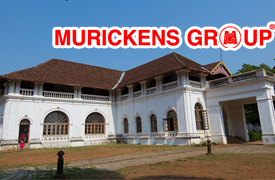
Among the more picturesque and historically-relevant sites in all of Thrissur is its famous Archaeological Museum. Originally in the Kollengode Palace building, it has now been moved to the Shakthan Thampuran Palace. This beautiful building once was the seat of the Perumpadappu Swaroopam, the former ruling dynasty of Kochi, and now houses some of the finest murals from across God’s Own Country. Step inside and one is immediately made aware of the unique treasures this place holds, including Veerakallu, temple models, olagrandhangal (manuscripts on dry palm leaves) and megaliths. Veerkallu (herostones), especially, catch the intrigue of all new visitors. These stone engravings and sculptures of figures and weapons belong to a bygone era, and were found in the forests of Thrissur and Wayanad. Other important exhibits include earthen pots, urns and special temple models that are some of the best representations of holy sites across all of Kerala. Visiting Hours: 10:00 - 17:00 hrs.on all days except Mondays and National Holidays.
The art museum in a separate building in the Zoo compound, is a treat for the connoisseur of art. Good collection of wood carvings, metal sculptures and ancient jewelry are preserved here.
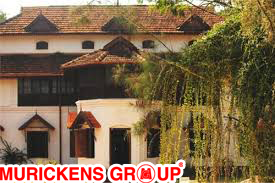
Mural Art Museum is the only museum dedicated to mural arts in Kerala. It is situated in Kollengode Palace in Thrissur, India. Thrissur being the cultural capital of Kerala, is home to various arts and culture related outlets. It was started as a part of SreeMulamChithrasala in 1938. Afterwards it was an archaeological museum and in 2009 it was renovated and opened to the public. The museum houses a gallery of murals from all over Kerala and preserves a rare treasure of Veerakallu, temple models, manuscripts written on palm leaves, life-size statues of eminent personalities, a megalith collection consisting of earthen pots, Nannangadi (urn burials) black and red wares, black wares russet coated wares, stone age tools, excavated materials from Indus Valley Civilisation and Harappa and CheramanParambu, Kodungallur. The murals here are not just contributed by local artists but by artists from the world over. Murals refer to paintings being directly done on the walls and other such permanent fixtures. The museum not only plays host to these beautiful permanent paintings but also has on display various framed ones as well. This museum was started to not just encourage the existing artists and give them a good platform to display their artworks but also to motivate youngsters to take up the artform and appreciate its true beauty. Murals are ideally done on public walls and meant for public display as they capture the various moods and hues of the society as a whole. Apart from all the murals, the museum also houses several rare manuscripts that were written on palm leaves, old utensils and tools, rare relics that were excavated from the Harappa Mohenjodaro dynasty and also from Kodungallur. This museum forms a very important part of the cultural diversification of Thrissur and hence has become an absolute must visit place.
This is one of the tallest churches in Asia and is known for its Gothic model of architecture.
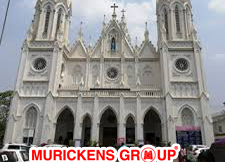
Puthan Palli, literally meaning new church, is situated in the center of Thrissur town in Kerala, South India and is the tallest church in Asia, with a central tower of 260 ft in height. This church is built over an area of 25,000 sq. ft, in a combination of Indian and Gothic styles of architecture. The church has eleven altars, one in the center and five each to both sides. It has high belfries and double storeyed aisles. The two front towers are lesser in height than the main tower being of 146 ft in height. The work on the church was started in 1929 and was completed over a period of several years in phases.Our Lady of Dolours Basilica alias Puthanpally is a minor basilica of the Syro-Malabar Catholic Church in Thrissur City in the Indian state of Kerala. The third tallest church in Asia, it is famous for its Gothic style architecture. Built in fine Indo-Gothic style with an area of 25,000 square feet (2,300 m2), it has soaring belfries at the entrance, double storeyed aisles all along the nave and transepts, and eleven altars, five on either side of the main one. It is the largest church in India and its exuberant interior decorations include fine specimens of murals, images of saints and scenes from the Scriptures.
Eight Km. journey from the town on the Kunnamkulam road leads to this picturesque hillock known for its scenic splendour overlooking the sprawling town and country side.
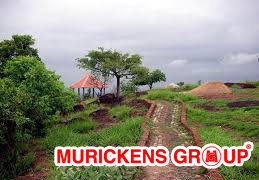
Vilangankunnu is a situated in 7 km away from Thrissur. This hillock has been converted by the Tourism Department as an amusement park. This is a beautiful hill which is a good picnic spot. The Children's Park on this beautiful hillside picnic spot offers amusement rides, where children can relax and play. While grown ups relish the scenic beauty of Thrissur town and kol wetlands of Thrissur from the hilltop. Many people came here to enjoy the beauty of sunset. The breeze of Vilangankunnu that pass through heart make us cool, and bring us to the world of natural beauty. The Tourism Department as well as State Medicinal Plants Board, Thrissur joins hands to make the hill more greenish, so in future Vilangankunnu become a notable tourist place in Thrissur. Passengers can reach here by traveling 5 km on Thrissur-Kunnamkulam road. It remains open from 07.00 am until 07.00 pm.
Vilangan Hills is a hillock located in Adat Panchayat, near Thrissur city of Kerala state in India. The hill gives a panoramic view of Thrissur city and Thrissur Kole Wetlands from the top. The hill was referred as a Oxygen Jar of Thrissur city. The name 'Vilangan Kunnu' is a misnomer because 'Vilangan' itself means hill. There is no need of adding 'Kunnu' after 'Vilangan'. It is an ancient Malayalam word derived from proto-Dravidian language. Till the 1970s the word 'Kunnu' was not used by revenue authorities and locals. It is a recent addition. In Tamil too 'Vilangan' means hill.
Kerala Sahithya Akademy, Sangeetha Nataka Akademy and Kerala Lalithakala Academy are head quartered at Thrissur making the epithet 'cultural capital of Kerala' more meaningful.
Arattupuzha Temple, situated 16 Kms away from the town on the Thrissur- Kodungallor road, is known for its annual pooram festival held in April-May every year which is one of the most colourful carnivals of Kerala.
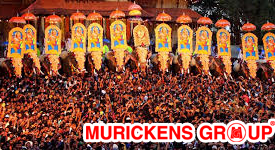
Arattupuzha is a village located near Puthukkad in the Thrissur district of Kerala in Southern India, approximately 12 kilometres (7.5 mi) South of the town of Thrissur.Located on the banks of the Karuvannur river, Arattupuzha is home to the annual Arattupuzha Pooram that stages the grand spectacle of numerous caparisoned elephants lined up in a row to the accompaniment of ethnic percussion concerts.Firework displays are also part of the celebration. The Arattupuzha Sastha Temple is located in Arattupuzha. The temple dates back 3000 years.
The Arattupuzha Temple is a Hindu temple situated at Arattupuzha in Thrissur district of Kerala in India, administered by Cochin Devaswom Board.According to legends, the antiquity of this temple dates back 3000 years. The temple has been the host of the most ancient and well-known yearly Devamela, a festival when all gods and goddesses assemble at Arattupuzha. It is believed that the deity of Arattupuzha temple is the embodiment of the divine potential of Guru Vasishta, the master of Rama.
This enchanting picnic spot situated 20 Kms east of Thrissur offers boating facilities in the reservoir. One can see tuskers on the bank of this reservoir

Peechi Dam lies at a distance of 23 km from Thrissur. The dam is the main irrigation project of this town of Kerala. It is a very famous attraction, and visitors come here now and then for the fantastic picnic spot it serves as and for the boating facilities which are offered at this reservoir. One can also come across Peechi-Vazhani Wildlife Sanctuary here which is a must-visit place for the nature-lovers. The dam is constructed across the Manali River. The dam is spread across an area of 3200 acres. When it was completely built in 1957, it could irrigate up to 17555 Ha of land present in Mukundapuram, Thrissur, Thalappally and Chavakkad Taluk. Peechi Dam also supplies drinking water to the town of Thrissur. Peechi-Vazhani Wildlife Sanctuary situated near the dam is worth paying a visit. It was built in 1958 and covers an area of 125 square km. It is home to a variety of flora and fauna. Ponmudi with a height of about 923 m is the highest peak in the sanctuary and experiences an average rainfall of about 3000 mm.
Kodungallur constructed in AD.629 is famous as the first mosque erected in India and also the first in India and second in the world where the Juma prayers were started. People from far and near irrespective of caste and creed visit this holy place and pay their homage.
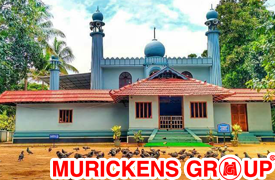 Idul Fitar (Ramsan) and Idul-Asha (Bakrid) are celebrated here on a grand scale.The significance of Cheraman Juma Majsid in the Muziris Heritage Project lies in the fact that it is the first mosque in India. Built in 629 AD by Malik Ibn Dinar it is located in the district of Thrissur in Kerala, on the Paravur-Kodungallur road.
The oral tradition is that Cheraman Perumal, the Chera king, went to Arabia where he met the Prophet and embraced Islam. From there he had sent letters with Malik Ibn Dinar to his relatives in Kerala, asking them to be courteous to the latter. The masjid is believed to have been renovated in the 11th century and also 300 years ago. The front portion was expanded in 1974 and further expanded in 1984. The older part of the mosque including the Sanctum Sanctorum is left untouched and is still preserved. Its grandeur is still kept alive by the wooden steps and ceiling. People of all religions come to this mosque and many non-Muslims conduct vidhyarambham (initiation ceremony to the world of letters) of their children here.
Idul Fitar (Ramsan) and Idul-Asha (Bakrid) are celebrated here on a grand scale.The significance of Cheraman Juma Majsid in the Muziris Heritage Project lies in the fact that it is the first mosque in India. Built in 629 AD by Malik Ibn Dinar it is located in the district of Thrissur in Kerala, on the Paravur-Kodungallur road.
The oral tradition is that Cheraman Perumal, the Chera king, went to Arabia where he met the Prophet and embraced Islam. From there he had sent letters with Malik Ibn Dinar to his relatives in Kerala, asking them to be courteous to the latter. The masjid is believed to have been renovated in the 11th century and also 300 years ago. The front portion was expanded in 1974 and further expanded in 1984. The older part of the mosque including the Sanctum Sanctorum is left untouched and is still preserved. Its grandeur is still kept alive by the wooden steps and ceiling. People of all religions come to this mosque and many non-Muslims conduct vidhyarambham (initiation ceremony to the world of letters) of their children here.
A shimmering expanse of tranquil beauty this waterfall, of 80 feet height 30 Kms.east of Chalakkudy. Athirappally attracts a large number of eco tourists. Vazhachal another water fall is 5 Kms. away from Athirapally. One cannot but watch this without breath taking splendour
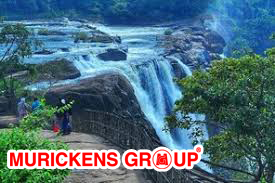
Athirappalli and Vazhachal Waterfalls in Thrissur 360° video link of Athirappalli and Vazhachal Waterfalls in Thrissur As you walk down the stone slabs that lead to the base of the Athirappalli waterfalls, a mysterious serenity overcomes you. It is Kerala's most famous and largest waterfall at over 80 ft high. The sight of the water crashing onto the ground leaves you with a sense of wonder at the sheer power and magnificence of nature. Located around 63 km from Thrissur district, it is a perennial picnic spot for people in the area and beyond. Its surrounding greenery is perfect for walks and picnics with loved ones. Lying at the entrance to the Sholayar forest ranges, it is a part of the Chalakudy River which calls the Western Ghats its home. Barely 5 km away is another family favourite, Vazhachal Waterfalls. These waterfalls became famous for not just their view but the endemic species found in the surrounding dense forests. Researchers have found four endangered species of the Hornbill here, the only place they thrive in the entire Western Ghats. Ornithologists attach great significance to this location and bird watchers can come across many rare and vibrant species in these parts.
Guruvayoor, one of the most sacred and important pilgrim centres of Kerala, is 29 Kms. north west of Thrissur. The main attraction is a temple dedicated to Lord Krishna popularly known as Guruvayoorappan. People throng here in large numbers for worship the year round.Guruvayur Sri Krishna Temple is a Hindu temple dedicated to the Hindu god Guruvayurappan (a four-armed form of the Hindu god Vishnu), located in the town of Guruvayur in Kerala, India. It is one of the most important places of worship for Hindus in Kerala and is often referred to as Bhuloka Vaikunta (Holy Abode of Vishnu on Earth).
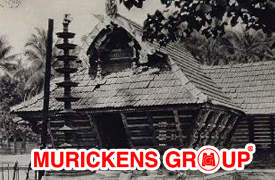
The presiding deity of the Guruvayur Temple is Vishnu, worshipped in the form of his avatar Krishna. The central icon is a four-armed standing Vishnu carrying the conch Panchajanya, the discus Sudarshana Chakra, the mace Kaumodaki, and a lotus with a Holy basil garland. This image represents the majestic form of Vishnu as revealed to Krishna's parents Vasudeva and Devaki around the time of Krishna's birth. Worship proceeds according to routines laid down by Adi Shankara and later written formally in the Tantric way, the inter-religious spiritual movement that arose in medieval India, by Chennas Narayanan Nambudiri (born in 1427). The Chennas Nambudiris are the hereditary tantris (high priest) of the Guruvayur Temple. The temple is managed by a special Devaswom (Guruvayur Devaswom) under the control of the Government of Kerala. The main festivals of this temple are the 10-day festival in the Malayalam month of Kumbham starting with flag hoisting on Pooyam star,Sri Krishna Janmashtami (Birthday of Lord Krishna) in the month of Chingam,Ekadasi (11th day) in the shukla paksha (bright fortnight) in the month of Vrischikam, popularly called as Guruvayur Ekadasi and Vishu on the first day of the month of Medam, once a harvest festival.The temple's sub-deities are Ganapathi, Ayyappan and Bhagavathi, and there are two sub-temples each, one for Ganapathi and the other for Nagadevata nearby the temple.
Kerala Kalamandalam at Cheruthuruthy was founded in 1930 by Mahakavi Vallathol. It's main objective is to revive, preserve and develop the ancient and traditional art form of Kerala particularly Kathakali. Now the Kerala Kala Mandalam is functioning at Vallathol Nagar with its new building complex at Natyagraha. The old Kerala Kala Mandalam is still at Cheruthuruthy on the shore of Nila River (Bharathapuzha).
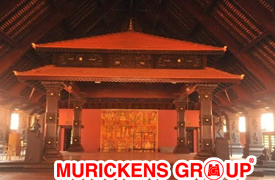 The Samadhi (Tomb) of the Poet Vallathol the founder of this famous institution is in the premises of old Kala Mandalam.Kerala Kalamandalam, deemed to be University of Art and Culture by the Government of India, is a major center for learning Indian performing arts, especially those that developed in the Southern states of India, with the special emphasis on Kerala. It is situated in the small town of Cheruthuruthy in Thrissur, Thrissur District on the banks of the Bharathapuzha river.The inception of Kalamandalam gave a second life to three major classical dance performing arts of Kerala as Kathakali, Kudiyattam and Mohiniyattam were, by the turn of the 20th century, facing the threat of extinction under various regulations of the colonial authorities.It was at this juncture, in 1927, that Vallathol Narayana Menon and Mukunda Raja came forward and formed a society called Kerala Kalamandalam. They solicited donations from the public and conducted a lottery in order to raise funds for this society.Kerala Kalamandalam was inaugurated in November 1930 at Kunnamkulam, Kakkad, and was later shifted to the village of Cheruthuruthy, just south of Shoranur in 1933. The Maharaja of Cochin donated land and a building. Subsequently, a dance department was started to revive Mohiniyattom.Kerala Kalamandalam has been functioning as a grant-in-aid institution under the Cultural Affairs Department, Government of Kerala. In 2006, the Kalamandalam was accorded the status of 'Deemed University for Art and Culture' by the Government of India. In 2010, University Grants Commission (India) has given 'A' category status for Kerala Kalamandalam. Kalamandalam is the only deemed university in Kerala state accorded the prestigious status.
The Samadhi (Tomb) of the Poet Vallathol the founder of this famous institution is in the premises of old Kala Mandalam.Kerala Kalamandalam, deemed to be University of Art and Culture by the Government of India, is a major center for learning Indian performing arts, especially those that developed in the Southern states of India, with the special emphasis on Kerala. It is situated in the small town of Cheruthuruthy in Thrissur, Thrissur District on the banks of the Bharathapuzha river.The inception of Kalamandalam gave a second life to three major classical dance performing arts of Kerala as Kathakali, Kudiyattam and Mohiniyattam were, by the turn of the 20th century, facing the threat of extinction under various regulations of the colonial authorities.It was at this juncture, in 1927, that Vallathol Narayana Menon and Mukunda Raja came forward and formed a society called Kerala Kalamandalam. They solicited donations from the public and conducted a lottery in order to raise funds for this society.Kerala Kalamandalam was inaugurated in November 1930 at Kunnamkulam, Kakkad, and was later shifted to the village of Cheruthuruthy, just south of Shoranur in 1933. The Maharaja of Cochin donated land and a building. Subsequently, a dance department was started to revive Mohiniyattom.Kerala Kalamandalam has been functioning as a grant-in-aid institution under the Cultural Affairs Department, Government of Kerala. In 2006, the Kalamandalam was accorded the status of 'Deemed University for Art and Culture' by the Government of India. In 2010, University Grants Commission (India) has given 'A' category status for Kerala Kalamandalam. Kalamandalam is the only deemed university in Kerala state accorded the prestigious status.
The Catholic Syrian church of Palayur is one of the seven churches founded by St. Thomas. The feast falls on July 15 and many pilgrims from different parts of India visit the church.
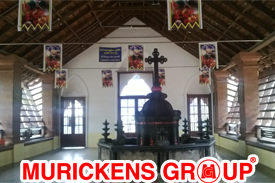
St. Thomas Church was established in 52 AD by St Thomas is located at Palayur. It is the oldest church in India and one of the seven founded by St. Thomas the Apostle. Original small Church structure has been retained at the oldest site. During the 17th century substantial improvements around it were carried out without relinquishing the main sanctitude of the place. However, after the church was fully completed and after the priest had delivered a proper sermon, the local people agreed to demolish the old wooden structure, which resulted in the Church looking elegant. The original altar consecrated by St. Thomas is still retained. Historical legend records that when St. Thomas landed at Palayur, he witnessed the sight of Hindu Brahmins at the Thaliyakulam adjacent to the then Palayur temple , offering prayers by chanting mantras to god in the form of Tharpanam to the Sun god. Amused by the sight of water being thrown up by the Brahmins , he challenged the Brahmins stating that the water they were offering was not being accepted by the Sun god as it was falling back into the tank. He made a deal with them stating that his God would accept the offer of water if he threw it up in the same way as they did, but water would not fall back. If he proved this then his God was superior and the Brahmins would have to embrace Christianity. He performed this miracle and with this miracle he converted a number of Brahmins and Jews in Palayur to Christianity.
The Koodalmanickam temple is an ancient and historic one situated in Manavalassery village about 10 Kms. from Irinjalakuda Railway station. Lord Bharatha is the deity of the temple. The festival is held annually for 11 days in Medom (April-May)
 - Murickens property for sale irinjalakuda.png)
Koodalmanikyam Temple or Kudal Manikkam Temple / Koodalmanikkam Temple is a Hindu temple which is situated in Manavalassery village, Irinjalakuda, Thrissur district, Kerala state, India. The temple comprises the main structure, walled compound with citadels, four ponds around the main structure where in one of the ponds is situated within the walled structure. Koodalmanikyam Temple is the only ancient temple in India dedicated to the worship of Bharata, the third brother of Rama, however the idol is that of Vishnu. "Sangameshwara"(Lord of the Confluence) is another name associated with the deity at Koodalmanikyam. The temple is one of four in Kerala state that form a set called "Nalambalam",each temple dedicated to one of the four brothers in Ramayana: Rama, Bharata, Lakshmana and Shatrughna. The Thachudaya Kaimal as "Manikkam Keralar" is the spiritual chief and the temporal ruler of the Koodalmanikyam Temple and its Estates. The line goes back to antiquity and is mentioned in the Skanda Purana. The temporal rights over the ancient temple, that is the office of the Kaimal (as opposed to "Manikkam Keralar") and the office of "Melkoyma".
Nineteen hundred years ago the first missionary of Christianity to India, St.Thomas, the Apostle set his foot at Kodungallur. The Mar Thoma Pontifical Shrine a monument to him is situated here. It is a historic pilgrim centre of the Indian Christians.
- Murickens Group kodungallur property for sale.png) The main feast of the church is celebrated on November 21 every year.The Marthoma Pontifical shrine is a major pilgrim centre that comes under the Muziris Heritage Project. The church, also known as Marthoma Pontifical shrine, on the banks of the River Periyar is located about 6 km from Kodungallur, in the village of Azhikode in Kerala. It is believed that St. Thomas , the apostle landed in Kodungallur on November 21st, 52 A.D. He is believed to have formed seven churches in Kerala, the first one being in Kodungallur itself. The bone of the right arm of St. Thomas was brought from Ortona in Italy and enthroned in the present Pontifical shrine. From then on, the shrine at Azhikode has been a great pilgrimage centre attracting thousands from all around the world, irrespective of caste and creed.
The 'Marthoma Smruthi Tharangam' derived from Sanskrit language which means 'the creation of waves of memories regarding St. Thomas' adjacent to the shrine, offers a memorial presentation of the mission of the Apostle. A 3500 square feet mansion built in the Indo-Persian style presents the major episodes in the life of St. Thomas. This programme of 30 minutes duration uses the aid of modern computer technologies and audio visual theatrical effects.
The main feast of the church is celebrated on November 21 every year.The Marthoma Pontifical shrine is a major pilgrim centre that comes under the Muziris Heritage Project. The church, also known as Marthoma Pontifical shrine, on the banks of the River Periyar is located about 6 km from Kodungallur, in the village of Azhikode in Kerala. It is believed that St. Thomas , the apostle landed in Kodungallur on November 21st, 52 A.D. He is believed to have formed seven churches in Kerala, the first one being in Kodungallur itself. The bone of the right arm of St. Thomas was brought from Ortona in Italy and enthroned in the present Pontifical shrine. From then on, the shrine at Azhikode has been a great pilgrimage centre attracting thousands from all around the world, irrespective of caste and creed.
The 'Marthoma Smruthi Tharangam' derived from Sanskrit language which means 'the creation of waves of memories regarding St. Thomas' adjacent to the shrine, offers a memorial presentation of the mission of the Apostle. A 3500 square feet mansion built in the Indo-Persian style presents the major episodes in the life of St. Thomas. This programme of 30 minutes duration uses the aid of modern computer technologies and audio visual theatrical effects.
MURICKENS GROUP
HO : KOTTAYAM-KADUTHURUTHY
BR : KOTTAYAM- CEMENT JUNCTION
ERNAKULAM-PALARIVATTAM
Real estate cunsulting officials at U.S.A. (Texas & Newyork) & Bombay
Email : mg@murickens.com, murickans@gmail.com